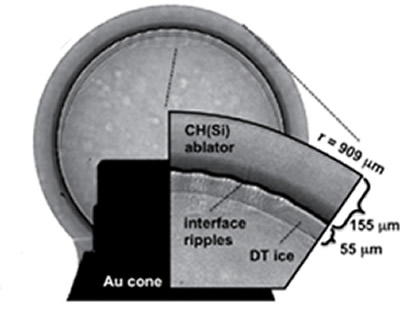Papers and Presentations - 2016
August
NIF-Related Research Papers Published
LLNL researchers and their colleagues recently published several NIF-related research papers in scientific journals. Here are summaries of two of the papers:
First Measurements of Fuel-ablator Interface Instability Growth in NIF Implosions
Understanding and mitigating the hydrodynamic instability growth occurring during the implosion of an inertial confinement fusion (ICF) capsule is essential to achieving the desired fusion performance and ultimately achieving ignition with ICF. Hydrodynamic instability is one of the degradation mechanisms responsible for the lower-than-expected performance of early NIF ICF implosions.
 Experimental setup for the layered hydrogrowth radiography (HGR) platform. A gold (Au) cone enters through the hohlraum and the capsule, allowing backlighter x rays to pass through half of the capsule and be recorded by the gated x-ray detector. The capsule has a silicon-doped plastic (CH) ablator with an inner deuterium-tritium (DT) ice layer. The experiment depicted here includes mode (wavelength) 60 perturbations, or ripples, between the ablator and the ice.
Experimental setup for the layered hydrogrowth radiography (HGR) platform. A gold (Au) cone enters through the hohlraum and the capsule, allowing backlighter x rays to pass through half of the capsule and be recorded by the gated x-ray detector. The capsule has a silicon-doped plastic (CH) ablator with an inner deuterium-tritium (DT) ice layer. The experiment depicted here includes mode (wavelength) 60 perturbations, or ripples, between the ablator and the ice. In a Physical Review Letters paper published online on Aug. 9, LLNL and General Atomics researchers described the first direct measurements of hydrodynamic instability growth on the interface between the deuterium-tritium (DT) fuel and the plastic ablator in NIF implosions. A series of hydrogrowth radiography (HGR) experiments used face-on x-ray radiography to measure the growth on the ablation front of preimposed perturbations, or “ripples,” seeded either on the outside or the inside of the capsule.
Separate experiments show that the growth starts in two ways—either from the preimposed interface modulation, or from ablation front feedthrough. The experiments are consistent with analytic modeling and radiation hydrodynamic simulations, which say that a moderately unstable Atwood number (the ratio of the density of lighter to heavier fluids in density stratified flows; the greater the Atwood Number, the more instability inside the fluid) and convergence effects are causing in-flight perturbation growth at the interface.
Good agreement between the simulations and the observed growth was found at several mode numbers (wavelengths). The analysis suggests that feedthrough from outer-surface perturbations dominates the interface perturbation growth at mode 60. Future experiments will test these conclusions at higher wave numbers and at higher convergence.
Lead author Chris Weber was joined on the paper by LLNL colleagues Tilo Döppner, Dan Casey, Tom Bunn, Rebecca Dylla-Spears, Bernie Kozioziemski, Andy MacPhee, Abbas Nikroo, Harry Robey, Jim Sater, and Vladimir Smalyuk and by Lane Carlson of General Atomics.
Increasing the Accuracy of NIF Hotspot Electron Temperature Measurements
In a Review of Scientific Instruments paper published online on Aug. 24, LLNL researchers reported on measurements of the electron temperature in the hot spot of layered NIF ICF implosions using a differential filtering diagnostic.
The researchers said measurements of the DT and deuterium-deuterium (DD) ion temperatures using neutron time-of-flight detectors are complicated by the contribution of hot-spot motion to the peak width, which produce an apparent temperature higher than the thermal temperature. The electron temperature is not sensitive to this non-thermal velocity and is thus a valuable input to interpreting the stagnated hot-spot conditions.
The researchers showed that the current differential filtering diagnostic provides insufficient temperature resolution for hot-spot temperatures currently reached in NIF implosions; they propose a new differential filter configuration utilizing larger pinhole size to increase spectral fluence, as well as thicker filtration. “This new configuration will improve measurement uncertainty by more than a factor of three, allowing for a more accurate hotspot temperature,” the researchers said.
Lead author Charlie Jarrott was joined by LLNL colleagues Robin Benedetti, Hui Chen, Nobuhiko Izumi, Shahab Khan, Tammy Ma, Sabrina Nagel, Nino Landen, Arthur Pak, Prav Patel, Marilyn Schneider, and Howard Scott.



